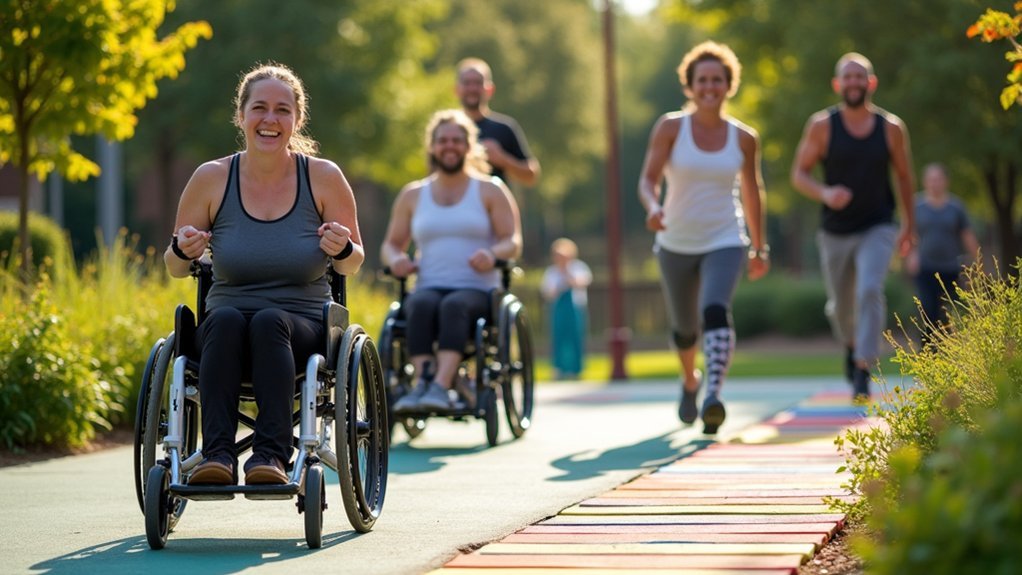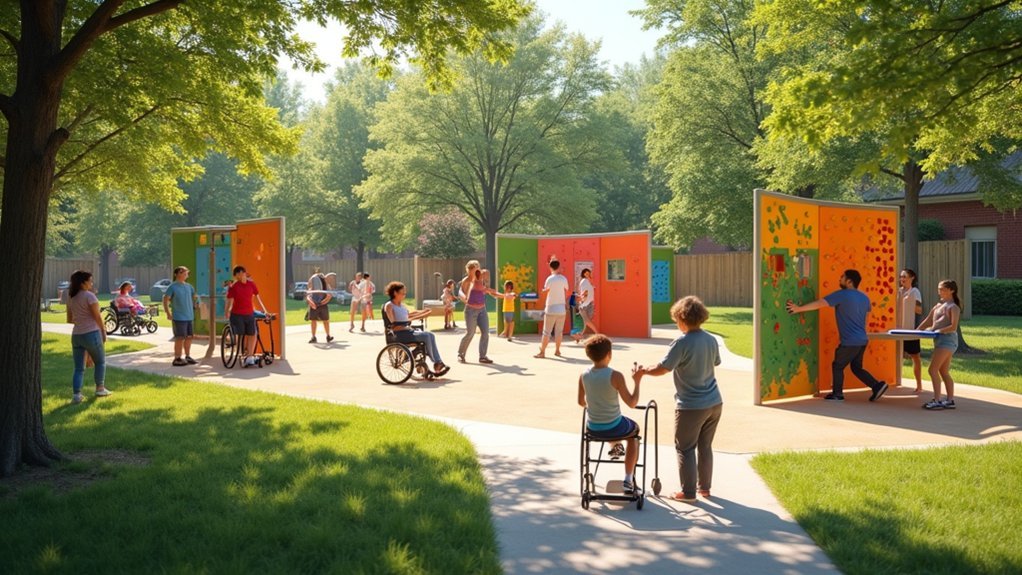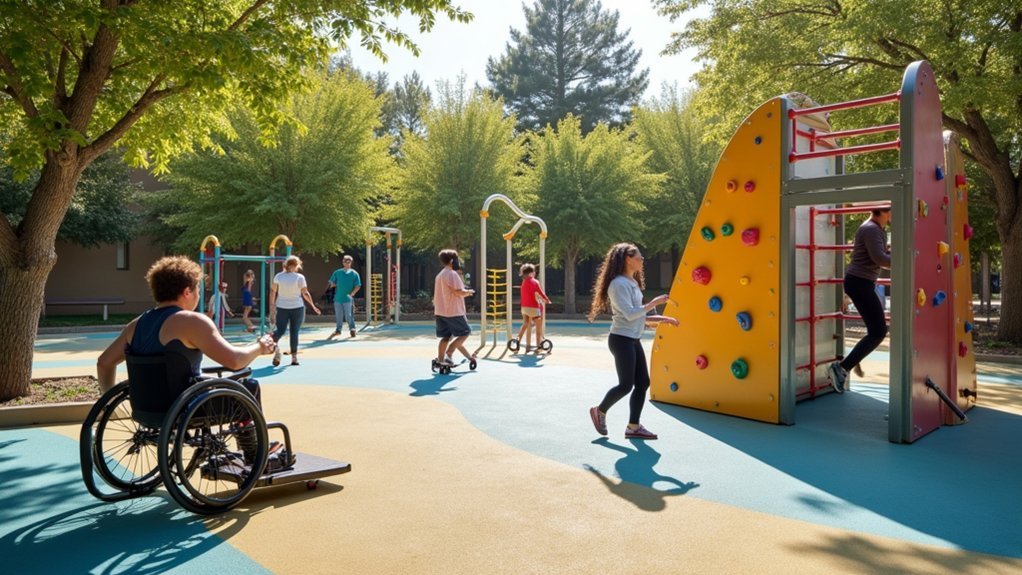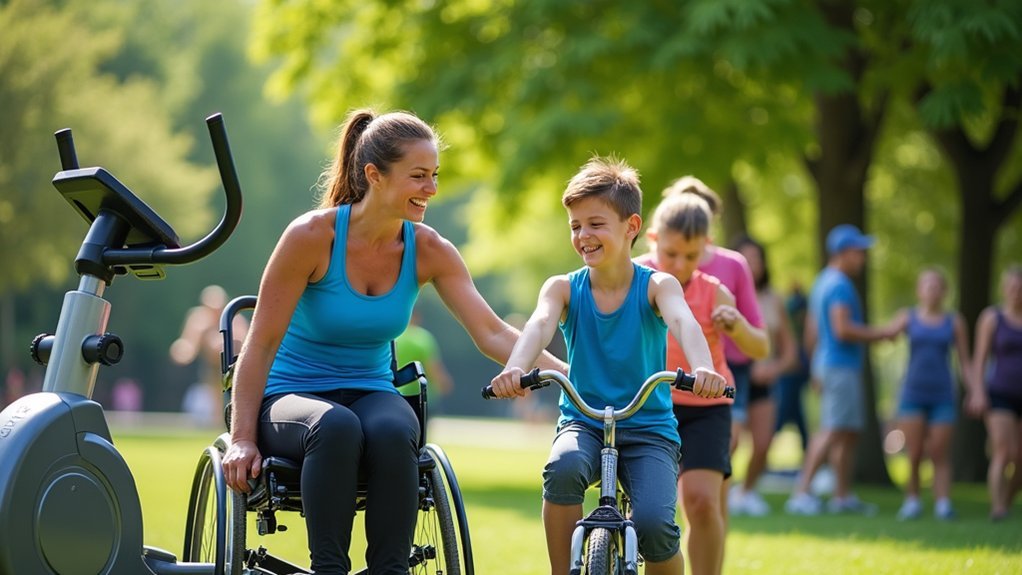Inclusive outdoor fitness equipment transforms public spaces into welcoming environments for all abilities. You’ll find wheelchair-accessible stations like ADA Chest Press and Hand Cycles alongside balance walks with supportive handrails. Look for bright color-coding and varied textures that help users with visual impairments navigate independently. QR-enabled equipment offers customized workout guidance, while strategically placed dual-function stations encourage side-by-side exercise and social interaction. These thoughtful design principles create truly democratic wellness spaces where everyone can thrive together.
Universal Design: Breaking Barriers in Outdoor Fitness Spaces

While traditional exercise equipment often excludes significant portions of the population, universal design principles are transforming outdoor fitness spaces into truly inclusive environments.
You’ll find accessible outdoor equipment specifically engineered to accommodate wheelchair users, with features allowing direct use or easy transfer from mobility devices.
Inclusive outdoor fitness equipment incorporates bright color coding and distinctive surface patterns that guide users with visual impairments, creating safer exercise environments for everyone.
High-contrast colors and tactile elements transform outdoor fitness spaces from exclusive zones into welcoming environments for those with visual challenges.
By integrating user feedback throughout the design process, manufacturers develop solutions that serve diverse needs and promote social interaction.
These thoughtfully designed fitness stations offer varied exercise options tailored to different capabilities, effectively dismantling barriers to community health initiatives.
When parks and public spaces adopt these principles, they’re creating truly democratic wellness spaces that welcome users of all abilities.
Adaptive Equipment Solutions for Diverse Mobility Needs
Universal design principles have reshaped outdoor fitness spaces, and now specific adaptive equipment brings these inclusive concepts to life. You’ll find wheelchair-accessible machines like the Dual ADA Chest Press that allow direct use without transfers, enhancing health and wellness for users of all abilities.
| Equipment Type | Key Benefit |
|---|---|
| ADA Hand Cycle | Upper body cardio accessible from mobility devices |
| Assisted Balance Walk | Handrails for enhanced stability during exercise |
| Accessible Parallel Bars | Strength and balance training for diverse abilities |
| Adaptive Strength Machines | Direct wheelchair access without transfers |
| QR-Enabled Equipment | Video instructions with exercise modifications |
These adaptive equipment solutions make outdoor fitness spaces welcoming for everyone, including older adults and those with mobility challenges. The scannable QR codes provide personalized guidance, ensuring proper form and appropriate modifications for your specific needs.
Sensory-Friendly Fitness Stations: Engaging All Users

Beyond traditional workout equipment, sensory-friendly fitness stations transform outdoor exercise spaces into inclusive environments that engage users across the sensory spectrum.
You’ll notice these stations feature bright colors and patterns specifically designed to enhance visibility for those with visual impairments, making outdoor workout equipment more accessible to everyone.
The stations incorporate varied textures and tactile elements, creating a multi-sensory health experience while minimizing sensory overload.
When you visit inclusive fitness circles, you’ll find these stations strategically placed for easy access, welcoming users of all abilities.
Community input has shaped these innovations, ensuring sensory-friendly fitness stations truly serve diverse needs.
Inclusive fitness designs flourish when built on the diverse voices of those they aim to serve.
The thoughtful design promotes not just physical health but also social interaction, making outdoor exercise a genuinely inclusive experience for everyone in your community.
Building Community Through Inclusive Outdoor Exercise
The true power of inclusive fitness equipment lies in its ability to transform public spaces into vibrant social hubs. When you install equipment like KOMPAN’s Inclusive Fitness Circle, you’re not just providing workout options—you’re creating gathering places where people of all abilities exercise together, building stronger community bonds.
- Color-coded zones improve accessibility for visually impaired users, ensuring everyone feels welcome.
- Dual-function stations like the ADA Chest Press allow mobility-impaired and non-impaired users to work out side-by-side.
- Group exercise activities around inclusive outdoor equipment naturally foster social interaction.
- Community fitness parks serve diverse demographics, from seniors to individuals with disabilities.
Maximizing Independence: Self-Guided Workout Options for Everyone

While creating accessible spaces marks an important first step, truly inclusive fitness equipment empowers users to exercise without assistance. At outdoor gym locations, you’ll find scannable QR codes linking to instructional videos tailored to various fitness levels. The equipment’s bright colors and color-coding help those with visual impairments navigate independently.
| Equipment Type | Accessibility Features | Benefits for Medical Conditions |
|---|---|---|
| KOMPAN Fitness Circle | Dual functionality for all users | Cardiovascular improvement |
| ADA Chest Press | Wheelchair accessible | Upper body strengthening |
| Hand Cycle | Adjustable resistance | Joint mobility enhancement |
| Inclusive Pull-Up Bar | Multiple height options | Core stability development |
| Balance Beams | High-contrast markings | Proprioception training |
Self-guided workouts become possible through thoughtful design elements like wheelchair-accessible equipment and handles that accommodate different grip strengths, ensuring accessible fitness equipment serves everyone’s needs independently.
Frequently Asked Questions
How Long Does Inclusive Outdoor Fitness Equipment Typically Last?
You’ll find outdoor fitness equipment usually lasts 10-15 years with proper maintenance. It depends on materials, usage frequency, climate conditions, and regular upkeep. Most manufacturers offer warranties ranging from 5-10 years.
What’s the Average Cost Difference Between Inclusive and Standard Equipment?
You’ll typically pay 15-30% more for inclusive equipment compared to standard options. The price difference reflects specialized design features, durable materials, and accessibility accommodations that make fitness possible for everyone.
Can Inclusive Equipment Withstand Extreme Weather Conditions?
Yes, most inclusive equipment can withstand extreme weather conditions. You’ll find they’re typically built with weather-resistant materials like stainless steel and UV-stabilized plastics, but you should still check manufacturer specifications for specific climate ratings.
How Much Space Is Required for a Complete Inclusive Fitness Area?
You’ll need about 1,500-2,500 square feet for a complete fitness area. This space allows wheelchair turning radius requirements, safety zones between equipment, and adequate circulation paths for users of all mobility levels.
Are There Specific Maintenance Requirements for Sensory-Focused Fitness Equipment?
Sensory-focused equipment needs regular cleaning with non-toxic products, inspection of tactile elements, lubrication of moving parts, and prompt replacement of damaged components. You’ll want to schedule monthly maintenance checks to guarantee continued safety and functionality.
In Summary
When you create inclusive outdoor fitness spaces, you’re giving everyone the opportunity to improve their health, regardless of ability. By implementing universal design, offering adaptive equipment, and creating sensory-friendly environments, you’ll build a stronger community where all feel welcome. Remember, true accessibility isn’t just about physical access—it’s about ensuring everyone can participate with dignity and independence in outdoor fitness activities.





Leave a Reply